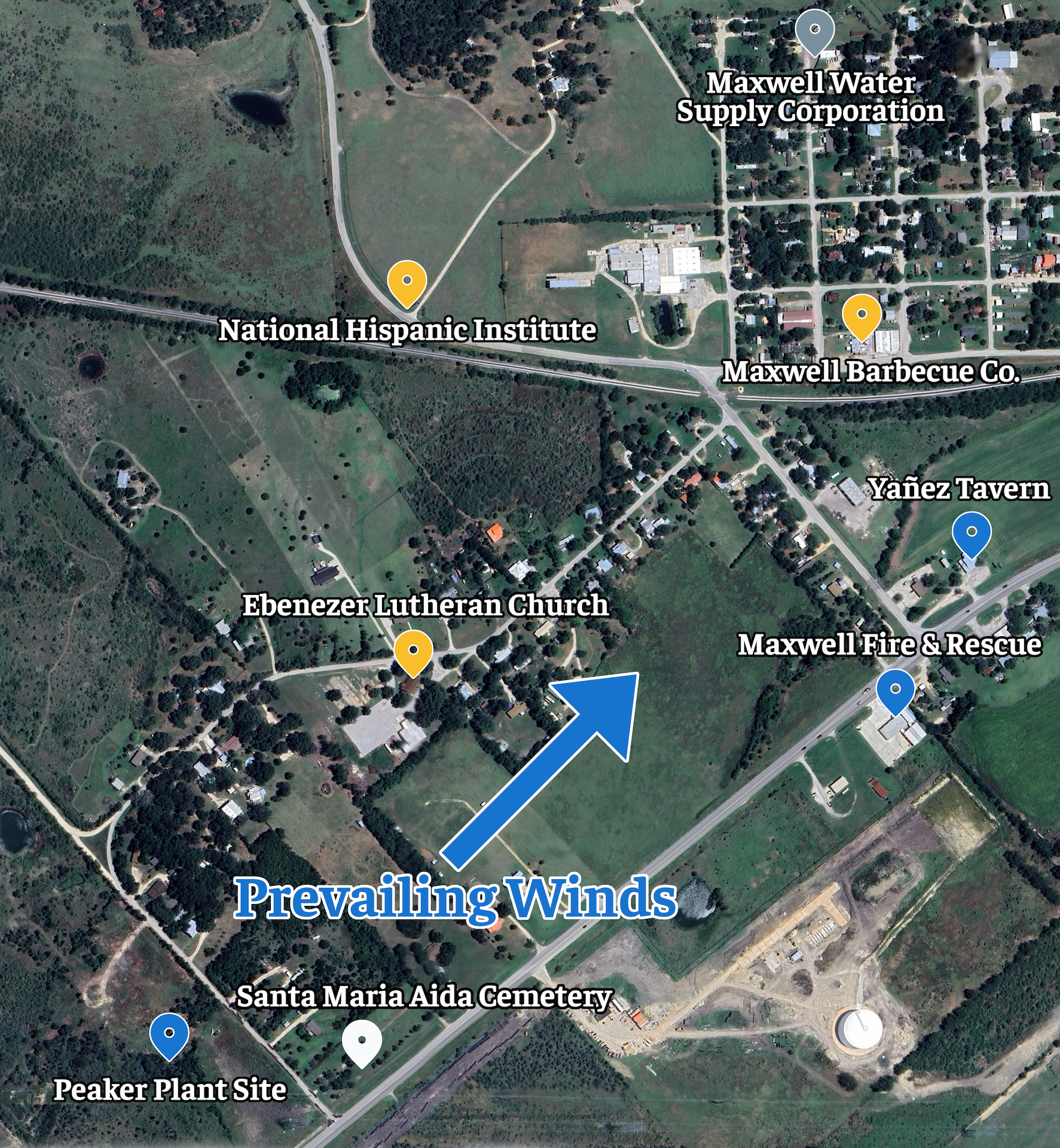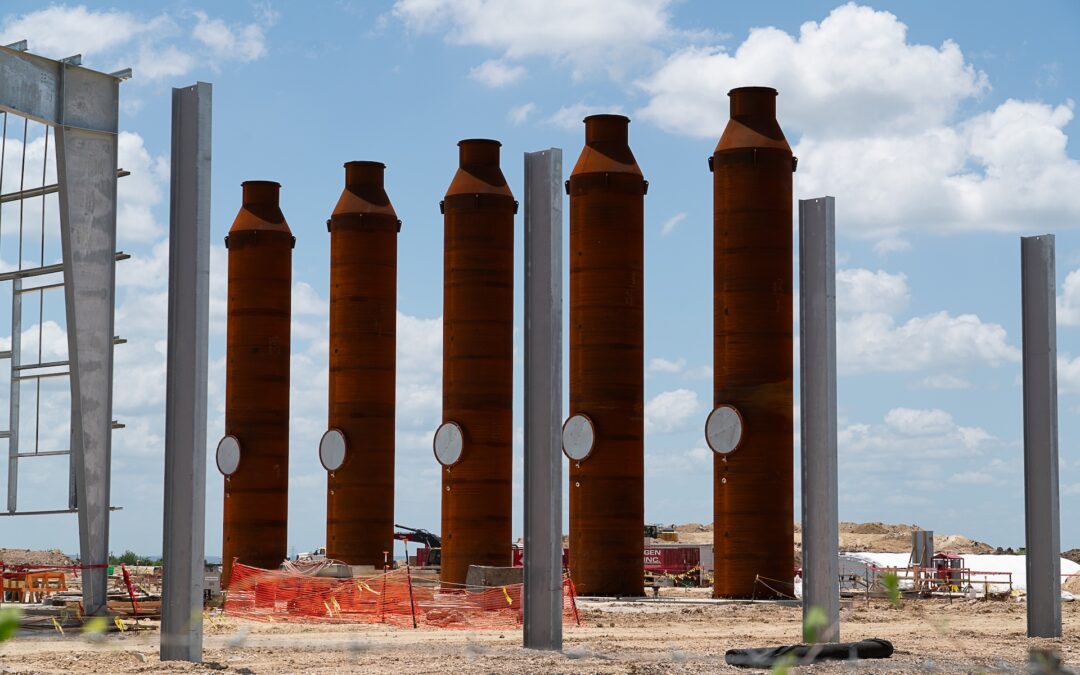Construction of the Timmerman Peaker Plant in Maxwell, just a few steps from Santa Maria Aida Cemetery and the Church Street neighborhood. Photo by Ursula Rogers.
Locals say they had no chance to voice objections to a new natural gas peaker plant being built across the street from residences and within a mile of the center of town
Construction of a natural gas peaker plant by the Lower Colorado River Authority (LCRA) is well underway in the Caldwell County community of Maxwell. The Timmerman Power Plant is expected to be operational in 2025.
While state officials like Gov. Greg Abbott and Sen. Judith Zaffirini have publicly applauded the additional electric capacity, the plant’s chosen location perpetuates a national trend of disproportionate environmental harms and adverse health outcomes for non-white, low-income, and indigenous populations.
Power plant siting
Power plants are disproportionately located in low-income communities and communities of color, the PSE Health Energy Research Group states, and this peaker plant is no exception.
In Texas, many peaker plants tend to be located in areas where nearby populations experience higher cumulative pollution and socioeconomic burdens than elsewhere in the state, according to a report from PSE. The site of the Timmerman plant is located across the street from about 10 homes and within 1 mile of the majority of the community of Maxwell, including several neighborhoods, a strip of restaurants and shops, the National Hispanic Institute, and the historic Ebenezer Lutheran Church.
The U.S. Environmental Protection Agency (EPA) explains that the emissions that come from burning fossil fuels at power plants contribute to ground-level ozone and particulate matter, which can lead to respiratory and cardiovascular problems. With power plants being located disproportionately in low-income areas and communities of color, the EPA notes, those populations bear a disproportionate burden of the associated health outcomes from emissions, including greater numbers of emergency room visits, hospital admissions, and premature deaths.
The EPA’s Environmental Justice Screening and Mapping Tool shows that the area where the Timmerman plant is located has a majority Hispanic and low-income population. According to U.S. Census data, nearly 12 percent of Maxwell’s residents were born outside the United States. Maxwell is part of the Martindale census district, where nearly 35 percent of residents speak Spanish at home.
Maxwell residents say they didn’t hear anything about the project until construction was underway.
“It was all very hush hush,” said Val Yañez, owner of the Yañez Tavern located less than a mile from the plant. “It hasn’t been talked about, what is coming out of the stacks, just that it’s helping the infrastructure.”
Residents also said they didn’t have any public opportunity to express concerns or gather information about health risks.
When asked why he thought there was no opportunity for public opinion, Yañez said, “Probably because we are a poor town and a poor county. Most of us have below median income. People would have been outraged, and there might have been pushback [if they heard about it].”
No hearings required?
Caldwell County Commissioner Ed Theriot says public hearings about construction of a natural gas plant are not required.
The plant is located in an area of Caldwell County where there is no zoning, however it is part of the extraterritorial jurisdiction (ETJ) of the City of San Marcos (COSM). The LCRA was required to apply for development applications with COSM, then for a Site Development Permit with Caldwell County, which is primarily for drainage.
The Site Development Permits are non-discretionary, Theriot said, meaning if a project meets code compliance standards, it will be approved.
“The Caldwell county Site Development Permit is a ministerial permit,” Theriot explained. The permit is administratively approved following a review for code compliance. There are no public hearings and the Commissioners Court does not take action on these permits.”
As far as the effects on the people in Maxwell, Theriot said, “I have not been informed of specific hazards or environmental concerns to the residents located near the peaker plant.”
Residents’ quality-of-life concerns
Without information from local authorities, residents have concerns about the plant, including health hazards and displacement.
Maya Yañez said she hadn’t thought much about the pollution, but expressed disappointment about the community changing with the added power plant.
“The concerns I’m hearing about are more personal than anything, it feels like we are getting closed in,” she said.
Lifelong resident Roy Duran’s sister lives across the street from the plant, and Duran lives around the corner.
“This was a sleepy little community,” Duran said. “All of a sudden we got LCRA making a ton of racket, it was sprung on us. Everybody was shocked. There’s people right across the street. They could have found land away from homes.
“We weren’t informed, so we couldn’t speak up. When you aren’t incorporated, with no city officials, no city council, we have no say,” Duran continued. “We couldn’t do anything. LCRA is a powerful corporation. My thought was what kind of effect will it have for people across the street. I’m right around the corner. Will there be environmental factors, is it a health hazard?”
LCRA Outreach
The LCRA said a representative went door to door to visit with residents and that the plant construction contractors have had ongoing conversations with neighbors as construction continues.
They left door hangers explaining what a peaker plant is and how it will aid in providing reliable and cost-effective electricity to the Texas power grid by operating “for brief periods when the demand for power approaches or surpasses the amount of power otherwise available.” It covered the dates of the construction and warned about “increased traffic and activity in the coming months.”
The hanger contained a QR code that linked to more FAQs, including information about natural gas and the Wärtsilä reciprocating engines that will be used. It also provided contact information for those who have questions about the plant (512-578-1549 or ContactLCRA.org).
The door hanger did not disclose information about expected emissions, noise, or light pollution that would come from the plant once it’s built.
Domingo Salinas lives across the street from the site with his relatives in homes they built in the 1980s. “The LCRA hasn’t told us anything about pollution,” he said. “It’s hard to keep the cars clean, there’s quite a bit of [construction] dust. My wife and I have talked about moving because of the noise and pollution.”
Salinas said the construction noise goes on day and night, and they had to get used to it.
“What can I say? They are doing what they are doing,” Salinas said.
Mary Martinez purchased 5.5 acres on Church St. in 2020 and built a home where she and her husband planned to retire, and close enough to care for her mother.
“We were excited to come out to the country from Kyle, to live and work in the community,” Martinez said. “Had we known that [the plant would be built], we wouldn’t have built.”
Martinez shares concerns with other community members about the natural gas plant, including potential safety issues and noise, light and air pollution. She wonders why the LCRA chose to build next to a residential area.
“I’m not happy about it,” Martinez said. “I hate thinking that there’s a possibility that I can’t come home one day. It just doesn’t seem safe. Who knows what it will do to our health?”
The LCRA said the location for the plant was chosen, “largely because of the availability of nearby transmission capacity and the proximity of the site to an existing nearby gas line that can provide fuel for the plant.”
When asked if nearby residents were considered in the decision to build there, LCRA said, “Decisions about issues such as lighting and noise have been made to enable the plant to operate reliably while minimizing local impacts to the extent that is functionally possible.”
The Texas Commission for Environmental Quality (TCEQ), not Caldwell County or COSM, is responsible for reviewing air emissions that will come from the new plant. TCEQ explained that the air permit required for this facility does not include any distance limitations for natural gas plants built near residences. Facilities are subject to comply with other state and federal air quality requirements, however.
TCEQ said all standard permits are evaluated for the health and safety of residents during the review.
The LCRA said the plant will be constructed and operated to meet all federal and state regulations designed to protect human health and the environment.
The City of San Marcos was asked to provide a comment about community engagement efforts, but they did not respond before this article’s publication deadline.
The Emissions Question
Total emissions expected from this plant are not any more than other Texas peaker plants
When operational, the peaker plant will provide enough electricity to power 142,000 homes.
Prof. Robert Mendelsohn, who studies natural gas emissions and consequential dangers to human health at Yale University, explained that the risk to human health depends largely on the height of the stack and the strength and direction of the winds. He lists particulate matter 2.5 (PM2.5) and ammonia as the most dangerous of the emissions to human health, with nitrous oxides (NOx and NO2) and volatile organic compounds (VOCs) being problematic but not nearly as lethal.
“The taller the stack, the more protected the immediate community … higher winds dilute the pollution and being downwind is a lot more dangerous than being upwind of the plant,” Mendelsohn said.
“Safety is in the eye of the beholder,” he noted. “The pollution will increase risk to human health. The increased risk is likely to be small and within limits set by the USEPA.”
The winds in Maxwell are primarily from the south and southwest. Weather Underground also shows a south and southwesterly prevailing wind for the town. The plant is slightly southwest from most of the Maxwell community, meaning the majority of residents live downwind of the property. The strength of the wind and the height of the stack will also impact where the emissions will settle.
Due to the variability of wind, emissions can settle anywhere from a couple of miles to hundreds of miles from the plant, so it’s impossible to say the exact effects that the residents of Maxwell might experience over long periods of time.
According to the PSE Healthy Energy Group, studies have found an association between living near power plants and increased respiratory and cardiac symptoms, increased emergency hospital visits among the elderly, preterm births, and respiratory-related hospital visits.
“The truth is that if Texas officials truly cared about grid reliability, they would connect ERCOT to the national grids. With that one change alone, we could’ve avoided 80% of the blackouts we suffered in Winter Storm Uri,” said Congressman Greg Casar (TX-35), whose district is within 3 miles of the plant. “Instead of building polluting plants in working class neighborhoods, we could work with the community on safer solutions — clean energy, batteries, grid connection, and new power capacity where there is actual community buy-in.”
The Examiner reached out to Maxwell’s Congressman, Michael Cloud (TX-27), for comments but had not received a response by press time.
More than 4.4 million people in urban areas in the United States live within 1 mile of a peaker power plant, and 32 million Americans live within 3 miles of one, according to the Clean Energy Group.
Natural gas-fired power plants use modern technology that allows them to start up quickly, similar to a jet engine. This feature is valuable to the grid, so that they can create energy needed during peak times quickly, but not waste energy when it’s not needed.
While the peaker plant will only be operating during peak energy use times, a study from the Union of Concerned Scientists found that natural gas power plants will start and stop much more frequently in the future as energy needs increase. Peaker plants emit three to seven times more pollutants during the startup period than when they are running at full load.
They do not typically create visible plumes of black or brown smoke like coal-fired power plants do, explained Dr. Neil Carman, former TCEQ regional field investigator and the Sierra Club Lone Star Chapter’s clean air director.
“The closest residents will not likely ever see such smoke emissions from a new operating gas-fired power plant, although there are emissions of less visible pollutants like nitrogen oxides, carbon monoxide, sulfur dioxide, particulate matter 2.5, volatile organic compounds, and small amounts of other pollutants,” Carman said.
Dr. Cori Zigler, an associate professor of Statistics and Data at the University of Texas at Austin said, “PM2.5 has been linked to a very large number of adverse health outcomes, including mortality. In fact, there is a ton of epidemiological research on the harmful health impacts of exposure to PM2.5. I don’t know of any specific distance threshold for harm, but the pollution from these power plants can harm populations that live hundreds of kilometers from the plants. This would be just one potentially harmful environmental contaminant that originates at gas plants.”
A California Energy Commission analysis studying a natural gas power plant found that nearby one-hour concentrations of one of the pollutants, NOx, would nearly double when plants were running.
The pollution from the plant is well within EPA and TCEQ standards, according to the approved permits, but any increase in NOx and PM2.5 emissions cause adverse health outcomes for communities where the pollution settles.
The Timmerman Peaker Plant will be a welcome addition to the Texas power grid for most Central Texans, aiding in power production during the times of greatest need especially during weather extremes. Maxwell residents remain reserved in their welcoming of the plant as they wait to see impacts of the air, light, and noise pollution on their
everyday life.

Maxwell, Texas: Google Earth/Data from Airbus
BY STEPHANIE GATES AND ROBIN BLACKBURN


0 Comments